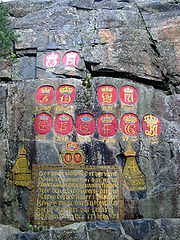
H7 (monogram)
Encyclopedia

Monogram
A monogram is a motif made by overlapping or combining two or more letters or other graphemes to form one symbol. Monograms are often made by combining the initials of an individual or a company, used as recognizable symbols or logos. A series of uncombined initials is properly referred to as a...
of the Norwegian head of state, King Haakon VII
Haakon VII of Norway
Haakon VII , known as Prince Carl of Denmark until 1905, was the first king of Norway after the 1905 dissolution of the personal union with Sweden. He was a member of the House of Schleswig-Holstein-Sonderburg-Glücksburg...
(7th), who reigned from 1905 to 1957. When Germany invaded Norway
Operation Weserübung
Operation Weserübung was the code name for Germany's assault on Denmark and Norway during the Second World War and the opening operation of the Norwegian Campaign...
in 1940 as a part of World War II
World War II
World War II, or the Second World War , was a global conflict lasting from 1939 to 1945, involving most of the world's nations—including all of the great powers—eventually forming two opposing military alliances: the Allies and the Axis...
, the royal family
Norwegian Royal Family
The Royal Family of Norway is the family of King Harald V of Norway. In Norway there is a distinction between the Royal House and the Royal Family. The Royal House includes only the King and his spouse, the Queen, the King's eldest son with spouse, being the Crown Prince and Crown Princess, and the...
fled the country, and Haakon VII later spearheaded the Norwegian resistance in exile in the United Kingdom. H7 became one of several symbols used by the Norwegian populace to mark solidarity and loyalty to the King, and adherence to the Norwegian resistance movement
Norwegian resistance movement
The Norwegian resistance to the occupation of Norway by Nazi Germany began after Operation Weserübung in 1940 and ended in 1945. It took several forms:...
.
During World War II
According to Minister of Foreign Affairs Bjørn Tore GodalBjørn Tore Godal
Bjørn Tore Godal is a Norwegian politician for the Labour Party. He was Minister of Foreign Affairs 1991-1994, as well as acting Minister of Foreign Affairs 1993-1994. He was then Minister of Foreign Affairs 1994-1996 and 1996-1997, and Minister of Defense 2000-2001 in the first cabinet Stoltenberg...
, speaking at the 50th anniversary for Victory in Europe Day
Victory in Europe Day
Victory in Europe Day commemorates 8 May 1945 , the date when the World War II Allies formally accepted the unconditional surrender of the armed forces of Nazi Germany and the end of Adolf Hitler's Third Reich. The formal surrender of the occupying German forces in the Channel Islands was not...
, Norway was the only country in which the initials of the head of state became a resistance symbol. The monogram, with H superimposed on 7, was drawn on fences, walls, houses, roads, in the snow and otherwise in the public sphere. It was also used in illegal art. Coins with the H7 symbol were also attached to clothes. Such coins were confiscated by the Nazi authorities. It was also used in the private sphere, among others on the inside of blinds.
A symbol used in a similar way was the "V for victory", as popularized by Winston Churchill. However, the Axis attempted to usurp this sign, supposedly with the new meaning of "V for Viktoria
Victoria (mythology)
In ancient Roman religion, Victoria was the personified goddess of victory. She is the Roman equivalent of the Greek goddess Nike, and was associated with Bellona. She was adapted from the Sabine agricultural goddess Vacuna and had a temple on the Palatine Hill...
". While this campaign was successful in most of Nazi-occupied Europe, it failed in Norway: Despite continued official use, the opposition also adopted the V-sign as an abbreviation of verlieren (German for "to lose"), and filled in the Nazi V's with the H7 monogram. In fact, this popularized the use of H7, which was soon drawn without the V.
The act of drawing or creating a H7 symbol in German-occupied Norway
Occupation of Norway by Nazi Germany
The occupation of Norway by Nazi Germany started with the German invasion of Norway on April 9, 1940, and ended on May 8, 1945, after the capitulation of German forces in Europe. Throughout this period, Norway was continuously occupied by the Wehrmacht...
was punishable by imprisonment. Another possible sanction was terror from Nazi paramilitary groups, to which the police were ordered not to respond.
Post-war uses
The symbol was also evoked after World War II to have a commemorative effect, among others at the first post-war Holmenkollen ski jump eventHolmenkollen ski jump
Holmenkollbakken is a large ski jumping hill located at Holmenkollen in Oslo, Norway. It has a hill size of HS134, a construction point of K-120, and a capacity for 30,000 spectators. Holmenkollen has hosted the Holmenkollen Ski Festival since 1892, which since 1980 have been part of the FIS Ski...
, when the symbol was formed in large scale by people. It was also used on post-war coins.

